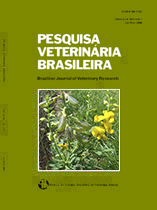 |
|
|
|
Year 2015 - Volume 35, Number 6
|

|
Identification and antimicrobial resistance of members from the Enterobacteriaceae family isolated from canaries (Serinus canaria), 35(6):552-556
|
ABSTRACT.- Horn R.V., Cardoso W.M., Lopes E.S., Teixeira R.S.C., Albuquerque A.H., Rocha-e-Silva R.C., Machado D.N. & Bezerra W.G.A. 2015. Identification and antimicrobial resistance of members from the Enterobacteriaceae family isolated from canaries (Serinus canaria). Pesquisa Veterinária Brasileira 35(6):552-556. Laboratório de Estudos Ornitológicos, Faculdade de Veterinária, Universidade Estadual do Ceará, Av. Paranjana 1700, Fortaleza, CE 60740-000, Brazil. E-mail: rubenhorn@hotmail.com
The Enterobacteriaceae family contains potentially zoonotic bacteria, and their presence in canaries is often reported, though the current status of these in bird flocks is unknown. Therefore, this study aimed to identify the most common genera of enterobacteria from canaries (Serinus canaria) and their antimicrobial resistance profiles. From February to June of 2013, a total of 387 cloacal swab samples from eight domiciliary breeding locations of Fortaleza city, Brazil, were collected and 58 necropsies were performed in canaries, which belonged to the Laboratory of Ornithological Studies. The samples were submitted to microbiological procedure using buffered peptone water and MacConkey agar. Colonies were selected according to their morphological characteristics on selective agar and submitted for biochemical identification and antimicrobial susceptibility. A total of 61 isolates were obtained, of which 42 were from cloacal swabs and 19 from necropsies. The most isolated bacteria was Escherichia coli with twenty five strains, followed by fourteen Klebsiella spp., twelve Enterobacter spp., seven Pantoea agglomerans, two Serratia spp. and one Proteus mirabilis. The antimicrobial to which the strains presented most resistance was sulfonamides with 55.7%, followed by ampicillin with 54.1% and tetracycline with 39.3%. The total of multidrug-resistant bacteria (MDR) was 34 (55.7%). In conclusion, canaries harbor members of the Enterobacteriaceae family and common strains present a high antimicrobial resistance rate, with a high frequency of MDR bacteria. |
| |
|
|
| |
|
 |